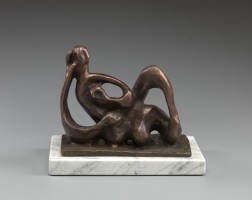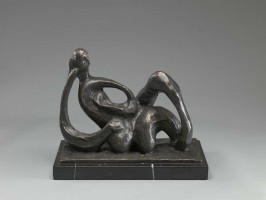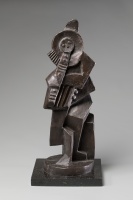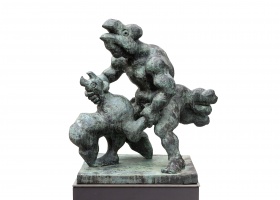
_web.jpg)
The Encounter
| Author: |
Jacques Lipchitz (1891–1973)  |
| Created: | replica of a 1913 composition |
| Material: | bronze |
| Dimensions: | 42 × 30 cm |
| Signature: | on the back of the thigh of the male figure: Lipchitz / 6/9 |
The composition The encounter is a replica of an early Cubist work. According to the artist, he was introduced to the style, and to Pablo Picasso, the ‘father’ of Cubism, by his friend the Mexican artist Diego Rivera in early 1913. Hence The encounter is an important work in Lipchitz’s career. This fact is confirmed not only by the replicas of the sculpture he made in the second half of his life, but also by one of the first monographs about Lipchitz. This was published by Irene Patai in 1961, under the title Encounters. The Life of Jacques Lipchitz. The reproduction on the cover of the book is, of course, a picture of the sculpture that gave it its name.
The Decalogue and the representation of the body. For a long time, society has incorrectly assumed that Jewish art does not allow the representation of the human body, because it is prohibited by the second commandment of the Decalogue: ‘You shall not make for yourself a carved imageor any likeness of anything that is in heaven above or that is on the earth beneathor that is in the water below’ (Exodus 20, 4). However, the second part of thiscommandment is often overlooked: ‘You shall not bow down to them or servethem’ (Exodus 20, 5). The second commandment of the Decalogue does notprohibit representations of the body, it only prohibits idolatry. Synagogues havebeen decorated with images of people and animals since Ancient times, narratingthe events of the scriptures. From the sixth century, when Christianity beganto use art more, synagogues depicted the human figure less. Rabbis were mostlyopposed to using sculptural images, fearing that a statue might become an objectof worship. So although the second commandment of the Decalogue hadan impact on Jewish art, it did not hinder its development, or affect the varietyof its plots and forms.
Interestingly, most of the first Litvak artists, such as Mark Antokolsky, Leopold (Lev) Bernstein-Sinayev, Jacques Lipchitz, Boris Schatz and William Zorach, were actually sculptors. These artists developed Jewish art, and shaped the aesthetic views and the artistic expression of the first generation of Jewish artists.
Text author Vilma Gradinskaitė
Source: Law firm Valiunas Ellex art album MORE THAN JUST BEAUTY (2012). Compiler and author Giedrė Jankevičiūtė, STORIES OF LITVAK ART (2023). Compiler and author Vilma Gradinskaitė, THE ART OF MATERIALS. Compiler and text author Jurgita LudavičienėExpositions: “More Than Just Beauty: The Image of Woman in the LAWIN collection”, 12 October – 11 November 2012, National Gallery of Art, Vilnius; “Life in Sculpture. Jacques Lipchitz – 125”, 1 July –25 September 2016, The Tolerance Centre of the Vilna Gaon State Jewish Museum, Vilnius; "A Glance at the History of Lithuanian Art from Užupis", 30 August 2018 – 1 June 2019, Lithuanian Art Centre TARTLE (Užupio St. 40, Vilnius). Curator Giedrė Jankevičiūtė; "Litvak Artists in Paris", 25 May 2023 – 29 September, Vytautas Kasiulis Museum of Art, Vilnius (curator Vilma Gradinskaitė).











_web.jpg)